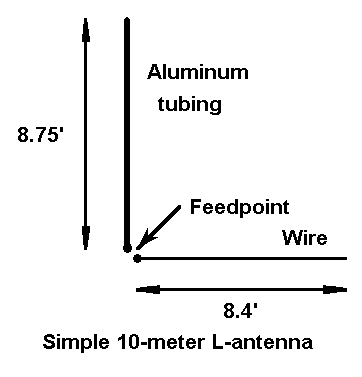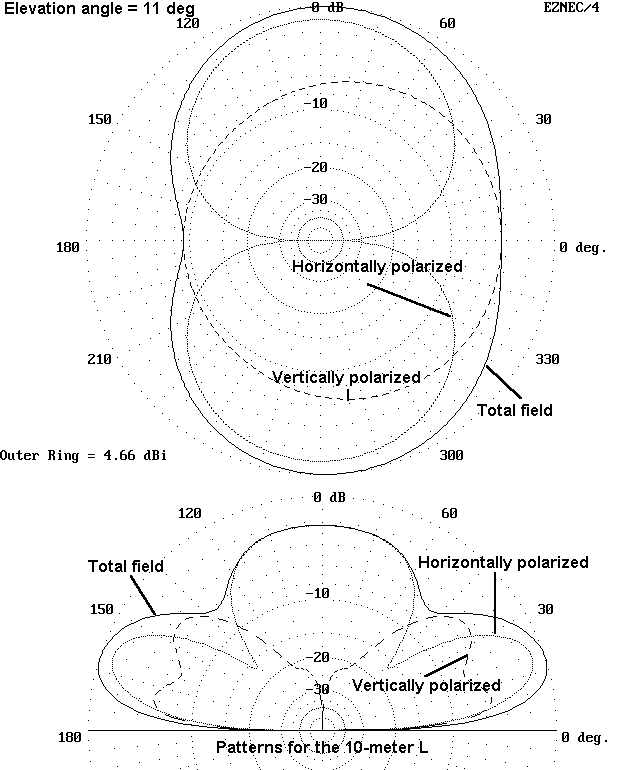 No. 25: The 10-Meter L-Antenna
No. 25: The 10-Meter L-Antenna

A large number of 10-10ers are just getting started. They are unsure of whether to go with a vertically polarized antenna or a horizontally polarized antenna. They have heard that cross polarization reduces signal strength by some amount from 3 dB on upward. They do not yet know what the prevalent polarization is in the local area. They do not want to put a lot of money into their first antenna, but they would like to enjoy 10 meters for both skip and local contacts. They may also have some severe space restrictions. What's a person to do?
There is a simple and cheap solution. But first, a little background. For skip paths, polarization makes no difference almost all of the time. The ionosphere skews polarization. Highly elevated beams have an advantage, but simple antennas perform well on 10 meters, whether vertical or horizontal.
Polarization makes the greatest difference with local area contacts, where line of sight is the general rule. Some of the gang run verticals, some horizontals. How to get started before one discovers which types of operating are the most fun is the tough question.
Why not make a simple L antenna out of hardware store supplies. Suppose you have a typical rooftop abut 25' up, and a chimney or similar solid mounting point. Less than 10' of aluminum tubing and less than 10' of copper or aluminum wire, along with some mounting hardware to keep the parts solidly mounted but insulated, will produce a nice compromise antenna.

The vertical section consists of 2 pieces of tubing in the 3/4" diameter neighborhood. The tubing is self-supporting once you fix the base area solidly. The horizontal portion is wire, perhaps running along the roof ridge, elevated at least a few inches and more if you can manage it. Dimensions are not too critical. You can adjust the wire horizontal part by pruning the far end. And you can adjust the vertical part by sliding one section of tubing inside the other before clamping.
Adjusting the antenna for minimum SWR will do just fine. The modeled feedpoint impedance is about 40-45 ohms, so it makes a good match for RG-58, RG-8, RG-8X, or RG-213 coax. I highly recommend a choke balun, such as the W2DU ferrite- over-coax designs, at the feedpoint to minimize RF on the outer braid of the feedline.
What do you get for your $15 investment? A pretty good local antenna with both vertical and horizontal polarization. The patterns above assume the antenna is mounted atop the typical 25'-high rooftop crest. As the patterns show, the vertical part produces a vertically polarized signal (and receives the same) that is almost as strong (or sensitive) as a pure vertical. The horizontal wire produces a horizontally polarized signal (and receives the same) about half as good as a full size dipole. The result is a low-angle total pattern shaped like a kidney bean that will handle signals, whatever their polarization.

By using light tubing for the horizontal piece, with perhaps a collapsible AM radio whip as the end section, you can make up a dandy portable or hill-topper antenna. A few nesting sections of PVC along with antenna pieces that also nest when not in use will make an antenna that takes almost no room in the car trunk. 5-10 minutes work, and you are on the air from your local scenic mountain or picnic area.
To get a better idea of the antenna's operation, think of it as an inverted Vee that has been rotated until one leg points straight up and the other is parallel to the ground. Unlike the Vee, this antenna is a good candidate for a rooftop or an attic.
In fact, if you must have an attic antenna, there is nothing wrong with using a Vee, either right-side-up or inverted, for getting a little polarization diversity to catch all the locals. Use 45-degree angles to maximize both types of polarization in the best compromise. If the L will not fit your attic vertically, then perhaps a Vee will fit the space.
For outdoor use, the L is likely a better mechanical choice, since you need only one solid mount and a secondary mount to keep the horizontal wire horizontal. The antenna has a minimal profile, and you can even put a PVC tube over the vertical tubing and fly a flag from it.
As with all elevated metal structures, be sure you have fat wire to a ground rod to bleed off charges built up by the weather. A 100 mH RF choke across the feedpoint terminals would not hurt either. Always build antennas with safety in mind.
So, if you are undecided about vertical vs. horizontal polarization, if you do not want to put a lot of money into an antenna while finding out which you prefer, or if you just need a good, cheap local antenna for 10 (that will also do quite well with skip), then the L may be right for you. When you finally invest in your long term antenna, you may want to keep the L in place as a back-up or for emergencies.
Updated 10-20-99. © L. B. Cebik, W4RNL. Data may be used for personal purposes, but may not be reproduced for publication in print or any other medium without permission of the author.